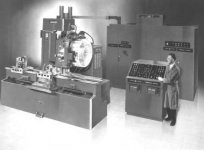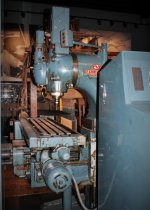NJ Mountain Man
Plastic
- Joined
- Jul 23, 2009
- Location
- New Jersey
Long time Lurker, Infrequent Poster. I have been to quite a few antique machinery museums and shows, and I have never seen any early NC lathes / mills out there. I was wondering if anyone out there still has a NC Lathe or Mill still out there operating. I guess technically the NC age started in 1949 with John Parsons and a Cincinnati Hydro-Tel Milling machine so I think this thread would be appropriate for this forum.
I am probably one of the younger guys collecting old machines, and have hoarded a bunch of antique machines. I was going through some paperwork at my grandmothers house, and I found my grandfathers NC training certificate from the 60's. It makes me wonder with all the commotion about robots "taking over jobs" lately that a huge part of our history in regards to Numerical Control is sort of forgotten. My grandfather would be close to 100 years old, I wonder how many guys are out there that ran these machines?
I am probably one of the younger guys collecting old machines, and have hoarded a bunch of antique machines. I was going through some paperwork at my grandmothers house, and I found my grandfathers NC training certificate from the 60's. It makes me wonder with all the commotion about robots "taking over jobs" lately that a huge part of our history in regards to Numerical Control is sort of forgotten. My grandfather would be close to 100 years old, I wonder how many guys are out there that ran these machines?



 Kwik-Switch spindle and an interesting set of geared resolvers to tell you where the table was. You did not have to home it because it could not lose its position. The corner of the table was 0,0 und by gott, that was what you programmed from. Manual feedrate control with a potentiometer. Had an eight-position depth stop on Z axis. Mechanical tape reader. Four position rotary table.
Kwik-Switch spindle and an interesting set of geared resolvers to tell you where the table was. You did not have to home it because it could not lose its position. The corner of the table was 0,0 und by gott, that was what you programmed from. Manual feedrate control with a potentiometer. Had an eight-position depth stop on Z axis. Mechanical tape reader. Four position rotary table.



